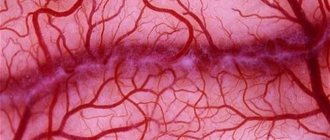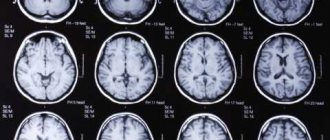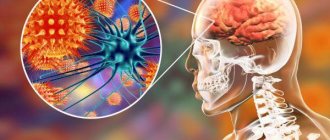There are a lot of diseases that lead to damage to blood vessels. Almost all of them are accompanied by similar symptoms. To correctly diagnose and establish the correct treatment, a comprehensive diagnosis is required. Venous encephalopathy of the brain is recognized as a concomitant disease, since it is always a consequence of other disorders in the functioning of the body. It occurs most often in old age, but can also be diagnosed in young patients, sometimes even in children.
Definition and concept of disease
In medical terms, venous encephalopathy is a complex of clinical manifestations and symptoms that indicate diffuse damage to the nervous tissue of the brain due to impaired blood flow.
The main feature and danger is the tendency of the disease to progress. This occurs due to a special venous circuit. The fact is that the outflow occurs through two jugular veins belonging to the superior vena cava system. The walls of veins are much thinner than those of arteries, so there is a chance of collapse. This occurs when the pressure of the cerebrospinal fluid (CSF) increases. The outflow is disrupted, stagnation occurs and pressure increases in this place.
Causes of pathology
The development of venous encephalopathy is diagnosed against the background of exposure to a variety of provoking factors and diseases. If the brain is inadequately supplied with blood, this becomes the cause of the disease. It develops in patients who experience severe stressful situations. People who work in hazardous industrial enterprises are at risk of developing a pathological process, which is explained by chronic intoxication of the body.
If a person has suffered severe poisoning, this becomes the cause of a pathological process. The cause of tumor disease in the brain is malignant and benign. Encephalopathy develops in patients after head injuries. If there is stagnation of blood in the jugular veins, this leads to increased intracranial pressure and the development of the disease. It appears with a hereditary predisposition. People whose grandparents suffered from the disease are at risk.
Encephalopathy appears in patients with various disorders in the functioning of the brain and the course of concomitant diseases.
Classification
From the point of view of clinical neurology, there are two forms:
- dystonic;
- acute congestion.
In the first case, the problem is a decrease in the tone of the walls of the veins located in the cranial cavity. In the second case, stagnation develops beyond its boundaries. Since the superior vena cava goes into the cavity of the right atrium and collects blood from the upper part of the body (head, neck, arms, lungs and bronchi), accordingly, in diseases characterized by impaired outflow in these organs, stagnation in the veins of the brain will follow.
Relevance of the problem
Despite modern methods of examining patients, new views on the diagnosis of nervous diseases and the development of medicine in general, venous encephalopathy is the most “unloved” disease among specialists. This attitude is due to several reasons:
- First, diagnosis is still difficult and gives mixed results.
- Secondly, precise approaches to studying the disease have not been developed for clinical researchers.
But such a disease cannot be neglected. According to statistics, from 5 to 22% of all older people have cognitive impairment due to vascular pathology. It is impossible to determine how many of them suffer from venous disorder. But it is assumed that the majority, since veins make up 85% of the cerebral vascular bed, and 15% are arteries and capillaries.
Diagnosis is often complicated by concomitant diseases such as chronic cerebral ischemia.
Although clinicians distinguish their forms of this disease, from the point of view of the international classification of the disease, 10th revision (ICD-10), there are only acute forms of venous encephalopathy. They are located under the codes:
- G08 – intracranial and intravertebral phlebitis and thrombophlebitis;
- I63.6 – cerebral infarction caused by thrombosis of cerebral veins, non-pyogenic;
- I67.6 – non-purulent thrombosis of the intracranial venous system.
All these forms are acute. However, according to domestic researchers, the chronic form is the most common.
The relevance of this topic is due to:
- high prevalence among the younger population (it is assumed that in people suffering from arterial hypertension in combination with atherosclerotic lesions of cerebral vessels at the age of 30–50 years, disturbances of venous outflow occur in 80% of cases);
- lack of clear criteria for treatment and diagnosis.
Causes of the disease
The etiology of the disease is not fully understood, but there are some factors in the development of the chronic course of the disease. All of them can be divided into systemic and regional. The most common system ones include:
- disruption of the central links of venous outflow;
- systemic venous insufficiency.
Sometimes the causes of systemic disorders are hereditary factors, such as connective tissue dysplasia. In this case, weak vein walls are formed that are unable to maintain the correct tone and pressure, and dystonia develops.
Regional causes are divided into:
- intracranial;
- extracranial.
The first group includes traumatic brain injuries, vein thrombosis and brain tumors. Compression of the more superficial venous vessels often occurs with compensatory expansion of the deep veins.
Extracranial causes are also called brachiocephalic and are associated with compression of the veins of the neck and upper chest. For example, with an increase in the size of the thyroid gland, a tumor process, lung diseases and increased intrathoracic pressure, severe muscle spasm. Congenital anomalies of the brachiocephalic arteries also play a certain role.
Characteristics of the disease
Venous encephalopathy is a pathological condition of the blood vessels in the brain, in which the outflow of venous blood is disrupted. Develops due to cell death due to lack of nutrition and oxygen. The disease always develops gradually, but is accompanied by clearly manifested symptoms that cannot be ignored.
Based on many years of research into the disease, we can conclude that with timely diagnosis and correct treatment, venous encephalopathy is completely curable. In extreme cases, regular monitoring of the development of pathology can significantly slow down the progression, and also allows the patient to maintain optimal conditions for a normal life.
Signs and symptoms of the disease
It is impossible to identify pathognomonic, that is, specific to a particular disease, signs. Typically, patients do not complain about deterioration of their condition, especially in the early stages of the disease. But as the disease progresses, the compensatory mechanisms of the vascular bed and brain tissue decrease and typical “venous” complaints form:
- cephalgia mainly in the morning or at night;
- addition of tinnitus;
- symptom of a “tight collar” - worsening of the condition when the tie is slightly tightened;
- “high pillow” symptom - worsening of the condition while sleeping with a low headboard;
- symptom of “sand in the eyes” - a strong feeling of sleepiness after waking up;
- slight pastiness of the eyelids and face in the morning.
For a complex of symptoms that are based on deterioration of the condition in the morning, the definition of “awakening encephalopathy” is used.
So, the clinical signs of venous encephalopathy:
- asthenic syndrome;
- "venous" complaints;
- neurological symptoms of a focal nature;
- headache of venous origin.
Main signs of venous encephalopathy
Among the signs of the disease, acute and chronic ones should be distinguished, each of which may not manifest itself for a long time.
The disease does not pose a direct threat to life, but significantly worsens its quality.
There are no specific symptoms of the disease; general symptoms include:
- Decreased mental activity, rapid fatigue when engaged in intellectual work.
- Deterioration in remembering events of the recent past, loss of short-term memory.
- Disturbances in the sleep-wake cycle, daytime sleepiness is most often accompanied by nighttime insomnia.
- Bursting headaches.
- Swelling of the face, the skin becomes pale with a bluish tint.
- Autonomic and cognitive disorders (ringing in the ears, flashing spots before the eyes, numbness and numbness of the limbs, weakness, sweating, feeling cold or hot at normal ambient temperatures, sometimes muscle cramps, a feeling of heaviness in the back of the head and neck). In some cases, an exhausting dry cough is observed, leading to vomiting.
If dyscirculatory encephalopathy is not treated, it can lead to more serious complications. Such as epilepsy, transient cerebrovascular accidents, Parkinson's disease, Alzheimer's disease, complete or partial paralysis due to acute cerebrovascular accidents, various types of mental illness
There are three stages of the disease - compensation, subcompensation and decompensation, each of which shows an increase in the symptoms described above. Pathological changes are reversible in the first two stages.
Hepatic encephalopathy is a pathology that can be fatal. Hepatic encephalopathy in liver cirrhosis has a reversible effect only if treatment is started in time.
What is post-traumatic encephalopathy and how to treat it, you will learn here.
Brain dysfunction, expressed in impaired blood supply, is called encephalopathy of mixed origin. This topic contains information about the features of diagnosing the disease and methods of treatment.
Diagnostics
At the first stage, an inspection and collection of complaints is carried out. Asthenic syndrome manifests itself in deterioration of sleep, memory and sudden changes in mood. Focal neurological syndromes are not always detected, but they include:
- nystagmus - oscillatory movements of the eyeballs to the sides with a high frequency;
- decreased reflexes;
- weakness of eye convergence - convergence of the axes of the eye when focusing on a close object.
In addition to general studies (urinalysis, blood analysis, ECG, ECHO-CG), other instrumental diagnostic methods are used:
- craniography (x-ray of the skull), where you can see the expansion of vascular grooves and canals;
- fundus examination: the state of the eye vessels determines the degree of blood stagnation;
- X-ray of the cervical spine;
- transcranial Dopplerography - ultrasound examination of the vessels of the head;
- magnetic resonance angiography (venography).
Since the disease is quite complex in terms of diagnosis, an accurate diagnosis can only be established after all the research has been carried out and the results have been deciphered.
Treatment
Modern medicine suggests starting treatment by following general recommendations. Regular physical activity, such as running, swimming, walking, will reduce congestion in the entire venous system and help nourish the brain and muscles with oxygen. Giving up bad habits and following a rational, balanced diet will also improve the condition of the whole body.
The treatment regimen includes the following methods:
- timely treatment of the underlying disease (heart disease, lung disease, diabetes mellitus, arterial hypertension, etc.);
- restoration of normal venous tone (taking venotonics - Ditamine, Detralex, Troxevasin and others);
- with increased cerebrospinal fluid pressure, a decrease in its production (taking the carbonic anhydrase inhibitor Diacarba);
- improvement of brain microcirculation (Curantil);
- prescription of angioprotectors (Actovegin);
- antioxidant therapy (taking B vitamins).
In preventive measures, it is possible to use Ginkgo biloba. For dementia or Alzheimer's disease, Galantamine, Rivastigmine and Memantine are effective.
You should not self-medicate, as this can lead to a worsening of the condition. Only a specialist selects a treatment regimen!
Traditional methods
Folk remedies for treatment should be considered as an addition to the main one and used only after consultation with a doctor. Typically these include herbal decoctions and teas:
- tea with mint, from linden, birch and lingonberry petals;
- infusion of 2 tbsp. l. hawthorn, steamed with boiling water and left overnight, and then drunk on an empty stomach;
- Brewed clover flowers after infusing in a thermos for 3-4 hours help get rid of tinnitus.
Prevention
Preventive measures include maintaining a healthy lifestyle, periodically visiting a doctor, and treating underlying diseases. Injuries to the skull, neck and back should be avoided. Stress is also a powerful factor in the development of the disease, so it is important to maintain a work and rest schedule and have adequate sleep of 7-8 hours.
An abnormal course of pregnancy can also lead to venous encephalopathy. Therefore, it is important for women to follow all doctor’s recommendations, eat right and monitor weight gain.
Forecasts for the future
The consequences of the disease depend not only on compliance with all doctor’s instructions, but also on the timeliness of the correct diagnosis. If the disease was noticed in the initial stages, then competent treatment will certainly give a positive result.
If the pathology was detected at a late stage, the disease will lead to irreversible damage to the nervous system.
Venous encephalopathy is a serious disease that in one way or another affects the patient’s further quality of life. To avoid serious disorders in the brain and maintain relative performance in the future, you should promptly seek medical help if any signs of pathology are detected. This is the only way to maintain a full life and avoid unwanted consequences.











